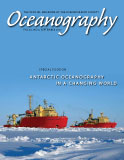First Paragraph
The densest waters in the world ocean are formed on the continental shelf areas around Antarctica by ice formation and by the loss of heat and water to the air. The Weddell Sea (e.g., Gordon, 1971; Carmack and Foster, 1975; Foldvik et al., 1985), the Ross Sea (e.g., Jacobs et al., 1970, 1985) and other continental margin areas such as the coasts of the Adélie and Wilkes Lands (e.g., Gordon and Tchernia, 1972; Carmack and Killworth, 1978; Foster, 1995) are known to be the major producers of these dense waters. These waters spill over the shelf edge and, during their descent, mix with components of Circumpolar Deep Water (CPDW) to form the Antarctic Bottom Water (AABW) that fills the major abyssal basins of the world ocean. This process constitutes an important pathway between the atmosphere and the abyssal ocean for long-term storage of CO2. However, the CO2 transport processes associated with bottom-water formation have not been well documented. Here, we present observations made during the 1992 World Ocean Circulation Experiment (WOCE) S4P cruise showing that atmospheric CO2 taken up by Wilkes Land shelf waters is transported into the upper AABW.

